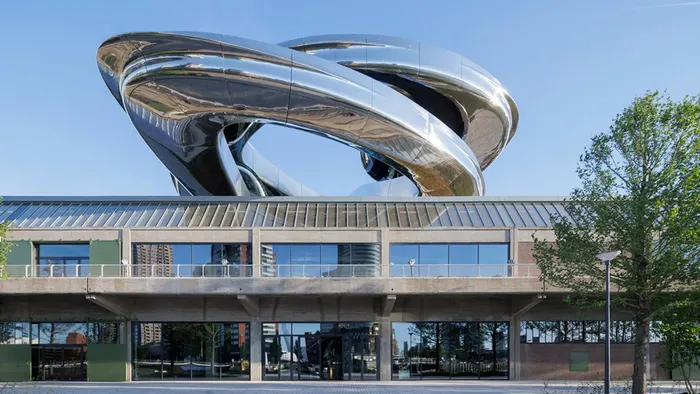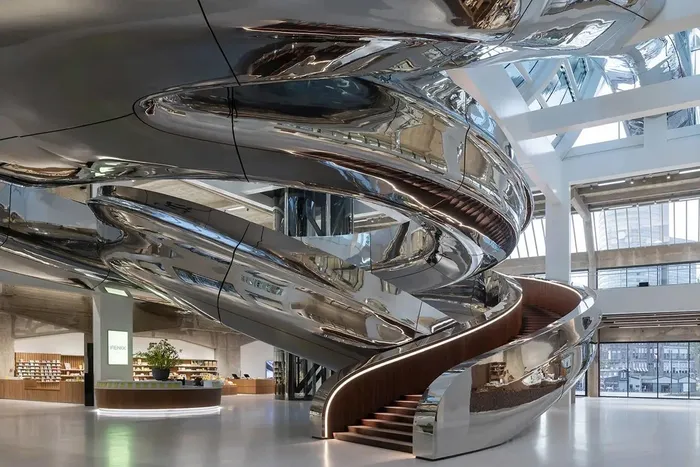Dutch museum is an architectural marvel with a mission

The "tornado" in Rotterdam houses the new Felix museum, dedicated to migrants.
Image: Supplied
Jessica van Dop DeJesus
The Tornado is one of the newest additions to the skyline of the historical Dutch port city of Rotterdam known for modern architecture. The towering, shiny steel staircases rise out of the new Fenix Museum that is dedicated to stories of human migration.
Ma Yansong, the founder of MAD Architects, says on the museum’s website that the weaving of stainless steel staircases symbolizes the twists and turns that many migrants encounter in their quest for a better life. The steps of the Tornado are shiny on the outside but steep on the inside, revealing that the journey may appear glamorous and adventurous on the surface but is actually challenging.
As impressive as the structure is on the outside, it’s the exhibits on the inside that will stay with you. In a moment when President Donald Trump is inspiring far-right politicians in Europe to ramp up anti-immigrant rhetoric, the exhibitions at the Fenix provide human context, engendering empathy and even provoking laughter.
As an immigrant myself, the twists and turns symbolized by the Tornado felt real to me. I exist because of migration: My parents leaped into the unknown, moving from Puerto Rico to the mainland United States in the 1950s. Later, I migrated to Europe, arriving in Brussels in 2006 on a student visa and feeling burned out from my deployment in Iraq as a young Marine Corps officer.
I remember how it felt to not know a single person in Belgium. I was navigating a language I barely understood and was humbled many times by the bureaucratic process of integrating into a new country. I wound up marrying a Rotterdammer. We’ve lived together in Washington, D.C., and now Brussels.

Ma Yansong, the founder of MAD Architects, says on the museum’s website that the weaving of stainless steel staircases symbolizes the twists and turns that many migrants encounter in their quest for a better life.
Image: Supplied
Tears, smiles and shackles
The art-focused Droom en Daad Foundation, which translates to “Dream and Reality,” funded the Fenix project. Led by former Rijksmuseum director Wim Pijbes, the goal is to share universal stories and “raise questions instead of giving answers,” using art and exhibits to capture the full spectrum of feelings associated with migration, from despair and suffering to hope and love.
“Migration is not good or bad, but a given,” Pijbes said. “As long as we exist, we move; it’s part of our DNA.”
Located in a former warehouse of the Holland America Line in the Katendrecht neighborhood, the Fenix opened in the spring in a poignant location: the very spot where countless European immigrants began their journey from the Netherlands to New York City. Holland America transported over 850,000 European immigrants to the U.S. between the 1880s and the 1920s.
Unlike the perfectly restored 17th-century rowhouses lining the narrow canals of Amsterdam, Rotterdam offers a different view of the Netherlands: The imposing Maas River cuts through the city, lined with glittering high rises and rustic barges.
The best way to start your visit is by taking a water taxi from the Maritime Museum to the Fenix, which offers one of the best views of the building from the water. Once you arrive at the Fenix, you can head to the rooftop for a stunning view of the city.
The first hall in the museum features a photo exhibition called “The Family of Migrants.” The collection showcases the faces of migration, from a young couple getting married in war-ravaged Lebanon to a child crying at the U.S.-Mexico border. It also highlights that migration isn’t limited by borders or passports, with portraits of Puerto Rican migrants settling in New York City in the 1930s.
It was impossible to leave this hall without being overwhelmed with emotion, especially knowing that my own parents embarked on a similar journey as they left Puerto Rico for a better life in western New York.
The “Suitcase Labyrinth” is a standout installation that takes guests through a maze of over 2,000 suitcases, the oldest of which dates back to 1898.
Visitors are encouraged to stop and listen to the stories of those who donated their bags for the project.
Artists throughout the museum teach us that migration is a complex human experience. For me, fond memories of New York arose from “The Bus,” by the American artist Red Grooms, who created a fabric bus featuring a cast of diverse people encountered in the Big Apple.
Similarly, Korean artist Kimsooja features an old white Peugeot pickup truck filled with bottari, a traditional Korean wrapping cloth used to carry belongings, in her installation, “Bottari Truck - Migrateurs.”
Migration can be mistaken as a solely voluntary process, but the slave trade is also a form of migration. The complexity of this era can also be seen at the museum, with different artworks and artifacts, including real shackles used to restrain enslaved Africans and a historical illustration of the Brookes slave ship, to show the horrifying transport conditions.
Artwork made of sugar by South African artist Zenaéca Singh shows the segue from enslavement to forced labor with indentured servants from India arriving in South Africa and the Caribbean.
As Pijbes succinctly put it: “We show it how it is, it’s part of history.”
The museum reinforces that migrants have unique stories, challenges and joys. Portraying these experiences through art allows viewers to form their own interpretations.